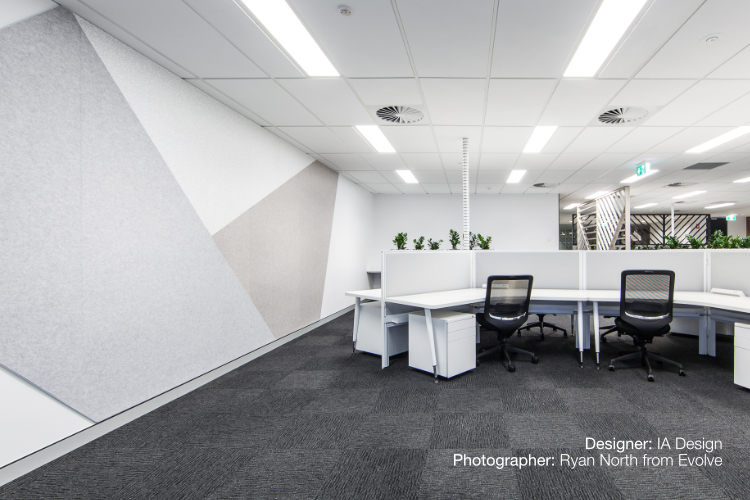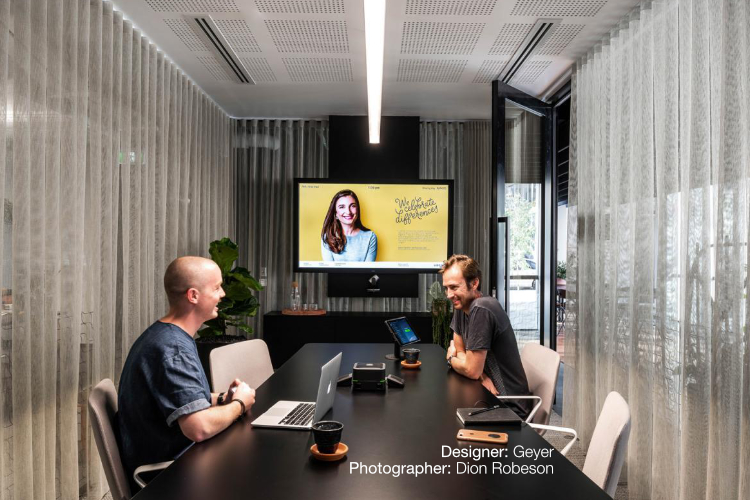While most offices in Australia have reopened, concessions have been made to protect staff health and wellbeing — including physical distancing and more flexible ways of working — which has inadvertently seen a huge increase in video conferencing.
It’s clear we are relying on technology now more than ever to maintain the connection and collaboration with colleagues, and customers or clients, that would normally occur face-to-face. And although good acoustic balance in the workplace has always been important to support staff health and wellbeing, it should be made priority number one as we adapt to doing more business online.
Many open plan office designs include designated areas for video conferencing and meetings and there is also a strong preference for creating ‘zones’ or ‘hubs’ that encourage staff collaboration and conversation away from the desk. These areas usually include seating, tables and whiteboards — all hard surfaces that can bounce sound around and can make it difficult to work effectively.
Sound bouncing around off hard surfaces has a fancy name — reverberation. To put it more technically, reverberation is the persistence of reflected sounds after the original sound source has stopped. According to Instyle Australia Ecoustic Business Manager Paul Leadbetter, it is one of the most common acoustic challenges in the workplace. In particular, speech intelligibility is critical in AV situations and relies heavily on reverberation control for these types of spaces to function successfully.
Achieving good acoustic balance in a workplace environment is also a consideration when designing WELL certified buildings. WELL is the leading tool for advancing health and well-being in buildings globally and is gaining traction in Australia as more firms look to measure, certify and monitor features of the built environment that impact human health.
It’s probably no surprise that reverberation — and poor acoustic design in general — in an office space can negatively impact staff behaviour, productivity, comfort and cognitive function.
“As studies prove, people function and feel their best when there is an appropriate balance of reflection and absorption within a space,” Paul said.
At COVRD, we understand each workplace is different and offer a large range of acoustic treatments suitable for a variety of interior applications such wall, window, ceiling and floor. We can also connect you with a reliable local acoustician at the start of the design process to help you manage the sound within the space effectively.
Below are a few examples of local projects featuring acoustic treatments from COVRD, and if you want to dive a little deeper into acoustics and understand more about NRC values and acoustic comfort you can read Instyle’s blogs on Improving Office Acoustics and Acoustic FAQs. In addition, we are now offering a CPD Presentation on Room Acoustics (1 Formal Point) and a more informal practical guide on acoustic design in commercial settings.
We would be thrilled to help with your next corporate fit-out or provide more information on the CPD Presentation — please feel free to get in touch.


Cockram: This light and neutral workplace features Instyle Australia’s Ecoustic Torque acoustic ceiling tiles (NRC 0.8), their sculptural aesthetic delineating the breakout space. The installation was quick and easy within the existing ceiling grid, providing the space with outstanding broadband sound absorption.


Alinta: Instyle’s Ecoustic Panels and ceiling tiles were installed to provide sound absorption across large open plan areas to encourage focused and flexible collaborative workspaces. Pictured here is Ecoustic Blade Ceiling Tile (NRC 0.40 – 0.85) White Wash Hemlock Profile 3060 – 7.


Pinsent Masons: Workstations should have low height sound absorptive screens to help minimise reverberation— high screens can give users a false sense of privacy leading to increased speech volumes and noisy offices. Instyle’s screen textile Source in Pride on workstations are complemented by soft carpet tiles from Shaw Contract’s Community Collection.


LWP: Instyle’s Ecoustic Panels feature as an angular pin board, helping to absorb unwanted noise in this dynamic property development company. The 8mm panels are installed in combination on both the walls and as workstation screens, providing sound absorption across the entire space.


Uber: Sheers and curtains are another way of controlling noise in an office space, particularly when used in meeting rooms on glass windows — Uber installed Zepel Fabrics Pointillism sheers to control reverberation here — or as privacy dividers between collaboration spaces.
Sources:
- A Practical Guide to Room Acoustics: CPD for Architects, Paul Leadbetter, Instyle Australia
- Improving Office Acoustics, Instyle Australia: https://instyle.com.au/room-acoustics-for-offices/
- Acoustic FAQs, Instyle Australia: https://instyle.com.au/acoustic-faqs/
- Designing healthy workspaces: results from Australian certified open-plan offices: https://www.smh.com.au/business/workplace/open-plan-offices-will-survive-this-pandemic-here-s-why-20200514-p54st6.html
- https://www.wellcertified.com/

